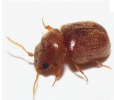
Problems with pantry pest and in particular cigarette beetles are entirely controllable under professional care. Our treatment goal is to stop a problem at its source so it doesn’t keep coming back. Using state-of-the art equipment and methods, our licensed exterminators will inspect your home’s environment and construction to identify the problem and determine the best course of action. Contact us today!
Cigarette beetle, (tobacco beetle), is very similar in appearance to the drugstore beetle and as indicated by its common name, it’s a pest of tobacco products, but it can also infest a variety of stored products such as oilseeds, cereals, dried fruit, sage, flour, cocoa beans, coffee beans, copra, coriander, cottonseed, and some animal products. It will also infest paprika, chili, and dried dog food.
Both adults and larvae are capable penetrating many types of packaging material to reach their food source. An interesting fact is that this insect can actually feed on pyrethrum based herbicides (and pyrethrum powder) strong enough to kill cockroaches. Adults are strong fliers and are attracted to light at night. Adult beetles flying around lights at night are often the first indication of their presence.
These beetles are small, red-brown to yellowish-brown and if viewed from above it appears oval or in profile its humpbacked in shape. Its length is is 3 to 4 mm. The antennae are serrated and the wing coverings are smooth without longitudinal grooves. This insect is found throughout the year, but seems to be more common in the fall and winter months.
The eggs are white, oval and too small to be easily seen with the naked eye. The larvae are white and grub-like; long hairs cover the bodies of the larvae and give them a fuzzy appearance. The female beetle will usually lay around 100 eggs on a food source and the hatching larvae will move around on and bore into the various food products. This insect’s life cycle takes 26 days at 98 °f and 120 days at 68°f. L. They usually die within a week in temperatures below 40 F.
The cigarette beetle can be controlled without the use of pesticides. The first step in control of the cigarette beetle is to find the source of the infestation. This means inspecting all of the dried foods in the infested cabinets or drawers. Once the infested material is found, it should be destroyed.
Clean all the cabinets and drawers with a vacuum cleaner (then throw the cleaner bag away). It is important that susceptible food material be stored so that adults and larvae may not have access to it. Glass jars and plastic containers with air tight covers effectively keep food insect-free. Infestations observed on food stored in either type of storage container are trapped and unable to spread to other food items.
Susceptible food items need to be tightly contained or stored in the refrigerator or freezer, or be consumed within two to three weeks of purchase. Infestations of dried flowers may be “fumigated” by placing a small amount of moth crystals and the flowers in a plastic bag for a day or two.